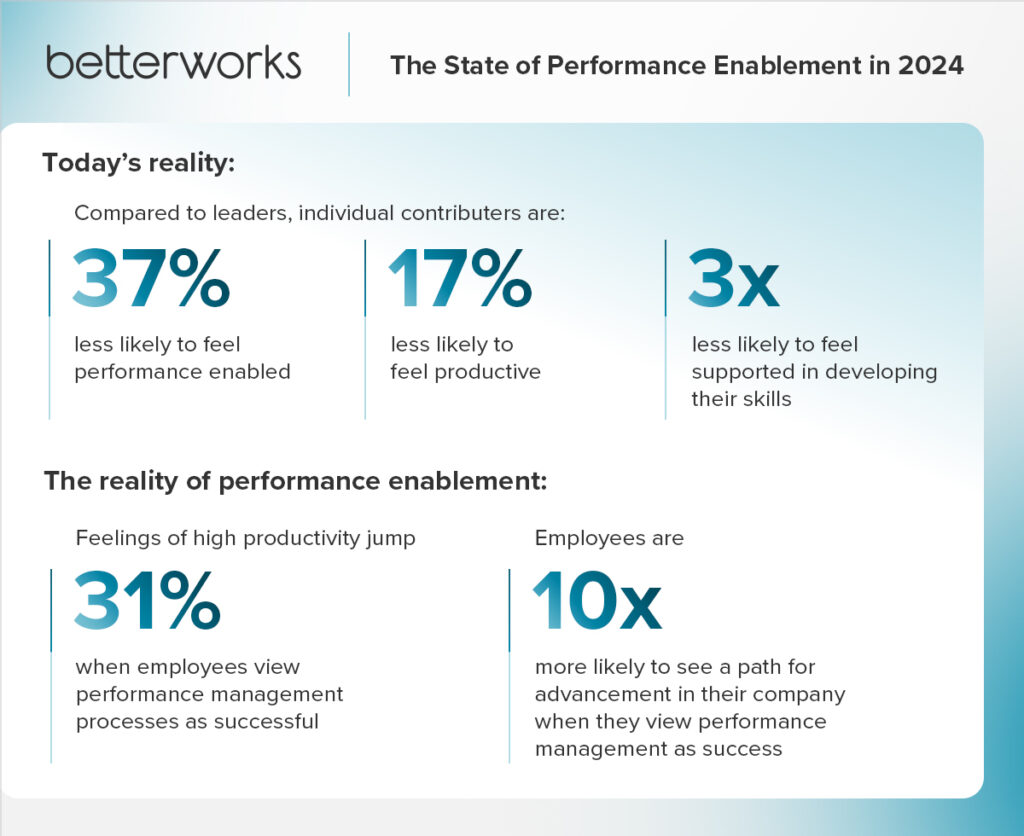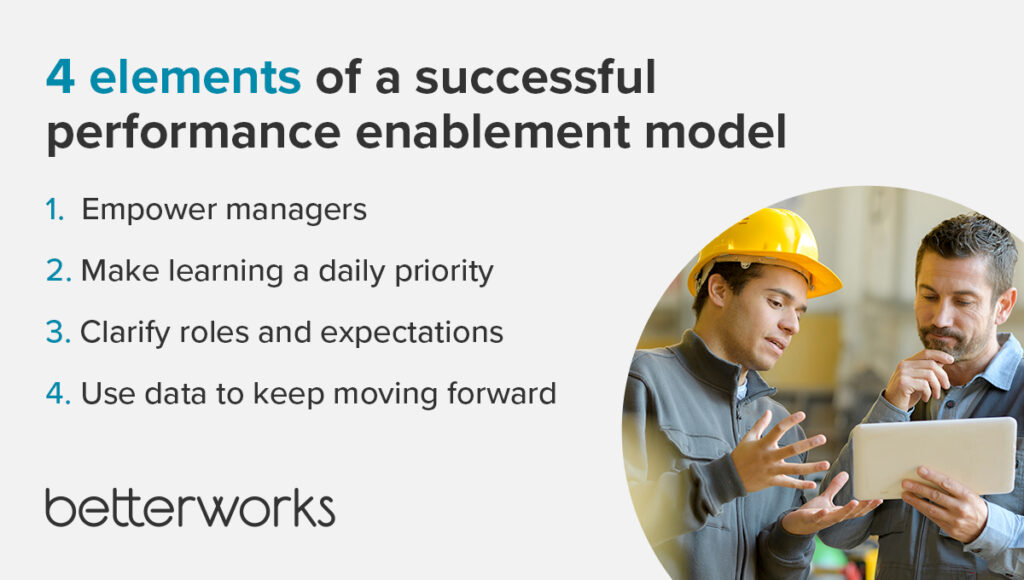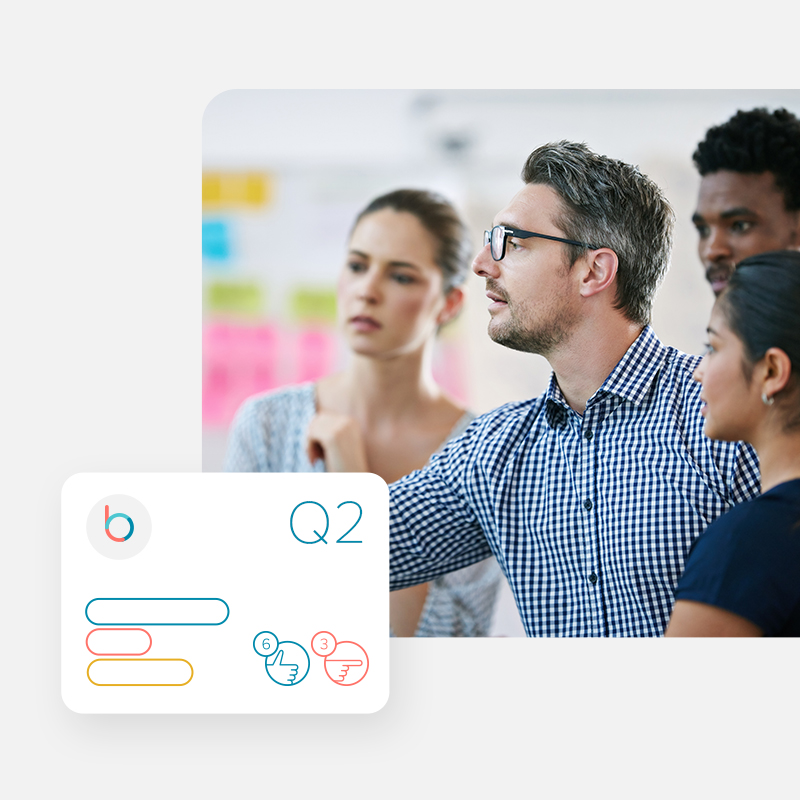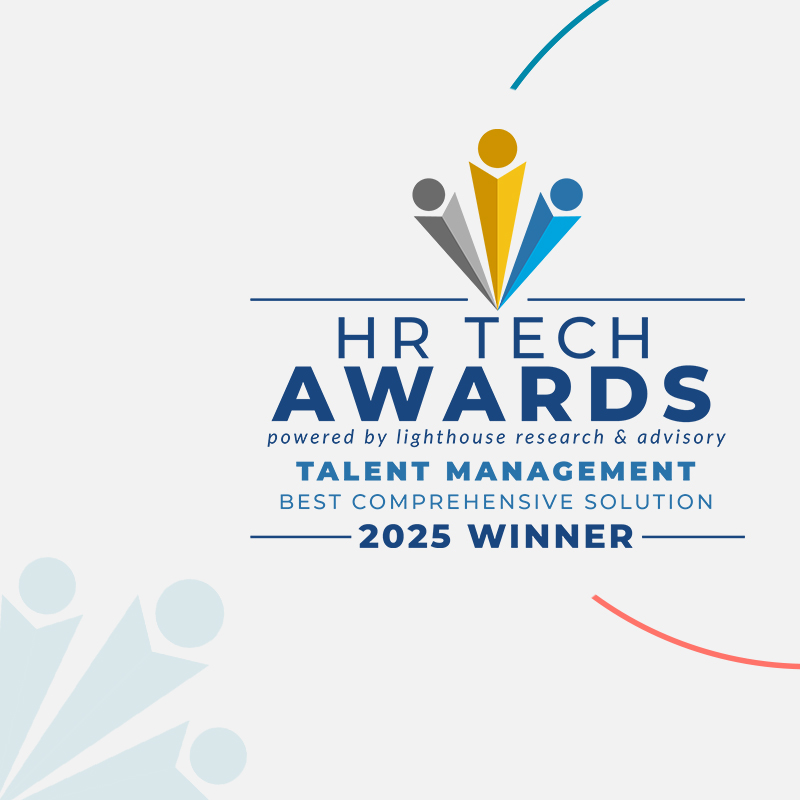Your business excels when every worker is empowered to achieve their full potential — but that can’t happen with legacy performance management processes. It’s time to embrace performance enablement, the next evolution of performance management.
Traditional performance management systems are static, backward-looking, and unable to recognize a person’s full potential. Enabling high performance, by contrast, is an ongoing process that affirms employee potential and prepares your people to grow.
Performance enablement is a powerful cognitive shift in the modern workplace. It gives workers the tools and resources needed to develop themselves and remain aligned with strategic goals to drive the business forward.
Learn how to implement a performance enablement model that empowers your people to succeed even in the most dynamic and challenging conditions.
What is performance enablement?
Performance enablement offers each employee a toolbox that’s tailored just for them, helping them do their best work. Unlike old-school performance reviews that only look backward, performance enablement focuses on ongoing support and real-time feedback. This approach equips everyone in the company with the resources and guidance they need to improve, achieve their goals, and grow their skills continuously.
It’s all about empowering employees, enabling them to contribute effectively to the company’s success while also advancing their own careers through continuous learning and achievement.
What is the performance enablement model?
The performance enablement model is a collaborative approach to improving employee performance by setting and achieving individual goals that align with desired business outcomes. With this approach, HR leaders give managers the resources they need to assess each worker’s current performance and ultimate potential. With assessment as their goal, managers become coaches who help employees achieve their professional goals within the company.
Because performance enablement is focused on building toward the future, managers are partners in their employees’ professional development rather than solely judges of their past performance.
Performance enablement vs. performance management
For employees to do their best work in today’s dynamic business environment, they require daily access to feedback, online coaching, and development — not just during a quarterly or annual review.
Performance enablement differs from traditional performance management in that it focuses on continuous support and development rather than periodic evaluations, emphasizing future-oriented growth and real-time feedback. This approach transforms managers into coaches who actively help employees align their personal goals with the strategic objectives of the organization, fostering a more dynamic and supportive work environment.
Traditional performance management looks backward, takes a narrow focus, and is infrequent — usually once or twice per year. That setup introduces recency bias, where short-term performance is overly emphasized. Reducing bias in performance management starts by delivering real-time feedback to employees.
Legacy performance management processes also reinforce power imbalances between managers and their reports. One bad appraisal can derail an employee’s career trajectory for years. So, instead of having a conversation about trying for ambitious goals, employees are simply trying to earn their manager’s approval. Performance enablement redirects this power dynamic by aligning employee performance with company goals and strategy.
The enablement model incorporates scheduled and unscheduled feedback and encourages employees to chart their career path within the company. With this approach, team members regularly get feedback on improving their performance and taking ownership of their business contributions and career goals.
You can apply a performance enablement model in any work setting — in-person, hybrid, or remote. This model relies on frequent conversations between employees and managers rather than an annual or semiannual performance review. By focusing on intentional and deliberate communication, you build trust between workers and their managers — regardless of their physical location.
The state of performance enablement in 2024
Our 2024 State of Performance Enablement report reveals crucial insights — and several big gaps — for HR leaders navigating today’s fast-changing work environment. Here’s what stands out.
There’s a disconnect between what HR leaders think about performance management systems and what employees actually experience. While nearly 9 in 10 leaders cite their own performance management as a success, 2 in 5 employees view it as a failure, a gap that leaves employees 17% less productive than leaders and 37% less likely to feel performance-enabled. Additionally, up to 40% of employees don’t receive regular conversations or feedback, which limits their growth, engagement, and productivity. Managers, as well, continue to be overburdened by increasing expectations from leadership and their employees. Two-thirds of managers seek role clarity, along with a desire for more organizational support in delivering performance management and guidance on career development and skills.
The report also highlights that, when it comes to enabling performance, HCMs out-of-the-box performance modules perform no better than manual spreadsheets — and in a few cases, they are worse. When companies add specialized performance management tools to their HCM systems, they can improve HCM performance by 70%. This combination helps employees develop their skills and grow within the company — essential outcomes for any company hoping to stay competitive.
Finally, the report makes it clear that HR needs to bridge the gaps — not just by adding technology, but also by granting access to tools and giving employees the support they need to succeed. HR leaders must create modern performance management systems — performance enablement — that truly support employee growth and align with the company’s strategic goals.

What is a performance enablement plan?
A performance enablement plan sets concrete goals for unleashing an employee’s potential. It should align with each employee’s objectives and key results (OKRs), and stretch goals.
Rather than waiting until performance falters to offer feedback, this model encourages managers to function as coaches who regularly check in on performance and goals. When managers are aware of their workers’ career goals, they can help match employees with the most relevant learning and experience opportunities.
4 elements of a successful performance enablement model
A successful performance enablement model is built on several key elements that collectively support a dynamic and engaging work environment. This model goes beyond traditional employee evaluations and seeks to actively empower individuals through ongoing support, development and real-time feedback. The focus is on nurturing talent, fostering open communication, and aligning personal goals with the strategic aims of the organization in a way that is transparent. These components are crucial for creating a workplace where employees are not only motivated but also have access to tools and opportunities they need to thrive and contribute meaningfully to their organization’s success.
Empower managers
Managers play the most important role in performance enablement, yet they have been underinvested in for years. Managers will be far more effective if they develop as coaches who collaborate with employees to identify and remove roadblocks to success.
HR leaders must assess manager roles and adjust their priorities — focusing managers less on operational tasks and more on coaching their team, for example. HR leaders should also work with learning and development leaders to add practical, scenario-based training to learning management systems. This type of training helps managers hone their coaching skills on an ongoing basis.
Make learning a daily priority
As you shift from performance management to performance enablement, embed workplace learning within employee workflows to help people develop their knowledge and skills.
Train managers to communicate which learning opportunities are inherent in an employee’s daily tasks and experiences. Each employee learns differently, so managers might start by introducing larger concepts, and then figuring out how best to practice them in daily tasks.
Clarify roles and expectations
Employees need to understand their manager’s performance expectations. One way to do this is by defining and documenting OKRs or goals for every role. As part of annual goal planning for the business, managers and employees should work together to set individual goals that align with company objectives.
Individual, team, and organizational goals should be communicated, along with updates as performance expectations and business priorities evolve. Employees should have on-demand access to goal dashboards so they can view progress, adjust learning goals, and seek feedback from their managers.
Use data to keep moving forward
Managers can leverage performance data points to hold employees accountable and gauge their contributions to overall business objectives. Data also informs each manager’s efforts to align individual goals with desired business outcomes. Make sure employees can see this data.
Performance data serves additional purposes, such as helping managers identify skills gaps and learning opportunities, provide personalized coaching, and recognize achievement.

3 benefits of performance enablement plans
Performance enablement models help employees feel supported and do work that supports business-critical priorities. Check out three benefits businesses get from successful performance enablement plans.
Higher revenue and profit
According to Gallup, organizations that prioritize employee development have 11% higher profitability and enjoy better retention. These organizations focus on empowering employees and encouraging innovation from the bottom up.
When employees have opportunities to build skills, pursue career goals, and achieve well-being, they perform better. Among the potential resulting outcomes are higher revenue and profit.
Unlocked employee potential
Performance enablement unleashes each employee’s potential by clarifying their goals and embedding them in a goals framework like OKRs. As a result, employees feel valued and can connect their goals to company strategy.
The performance enablement process encourages employees to think strategically about what they have to offer the business — and supports them on their growth path. Likewise, managers are equipped to support their workers and develop themselves, too.
A performance enablement plan can also help to prevent employee burnout by keeping team members informed and grounded in actionable next steps.
Progress on career growth and higher retention
Performance management can become overly focused on daily tasks, but performance enablement never loses sight of each employee’s distinct career aspirations — even if that means changing job roles or departments.
The manager’s role is to help employees explore their skills and interests, looking for the best fit within the organization. Performance management software can capture and store all kinds of workplace data, including from one-on-one conversations, peer feedback, and goal progress, helping HR to build a comprehensive skills inventory and create an internal talent marketplace. Employees’ ability to develop their skills and grow their careers internally will result in a drop in employee turnover.

3 performance enablement success stories
Performance enablement is gaining traction and driving organizational success within forward-thinking businesses. Here are three examples.
Grupo Posadas
Grupo Posadas, a leading hospitality company in Mexico, is an example of how performance enablement can modernize performance management processes while transforming the business. Posadas implemented the Betterworks platform and adopted an OKR framework. This strategic shift created alignment and accountability across their organization, which spans over 180 hotels and resorts.
Better performance enablement at Grupo Posadas began with a pilot group of 50 users within the executive committee and corporate strategy team. This targeted approach helped Posadas understand and trial the OKR methodology through monthly review meetings. This method improved performance and strengthened team cohesion.
The impact of this new approach became obvious during the COVID-19 pandemic. As Posadas navigated the shift to remote work, its performance enablement processes helped the company maintain focus and continuity. The Betterworks platform facilitates ongoing communication and alignment on performance goals, which was critical during this period of uncertainty.
By the end of this strategic overhaul, Posadas exceeded financial targets and reactivated its core business areas, showcasing the benefits of a well-executed performance enablement strategy.
Intuit
Intuit, the global technology company known for TurboTax, QuickBooks, and Credit Karma, has realized numerous performance enablement benefits. Intuit revamped its goal-setting framework to be more dynamic and reflective of its broader aspirations.
This shift was crucial during the COVID-19 pandemic, as Intuit could quickly recalibrate goals and support customers, particularly small businesses facing unprecedented challenges. By adopting a flexible, agile goal-setting approach, Intuit maintained its operational effectiveness and supported its employees through regular and constructive goal reviews.
Another use of performance enablement is Intuit’s transparent goal-setting process, in which employees at all levels have visibility into each other’s goals. This encourages collaboration, support, and alignment on objectives while helping each employee understand how their individual efforts contribute to the company’s strategic goals.
Intuit’s use of technology platforms like Betterworks helps employees integrate performance enablement into daily workflows, improving goal management and performance reviews.
Crakmedia
Crakmedia, a leader in web marketing and traffic monetization, has harnessed modern performance management techniques — and performance enablement tools like Betterworks — to drive lasting growth while sustaining a vibrant company culture.
By implementing structured onboarding processes and emphasizing continuous learning and personal growth, Crakmedia aligns each new hire with the company’s strategic goals from day one and reduces the timeline for reaching full productivity.
The company’s use of Betterworks has revolutionized how goals are set and reviewed. Crakmedia has 30-, 60-, and 90-day plans for new hires, using Betterworks to track progress and maintain alignment with company objectives. Regular reviews and follow-through on goals ensure that all employees, from individual contributors on up, know what’s expected of them and how to achieve those objectives.
Frequently asked questions
Performance enablement is a relatively new concept. Here are answers to some of the common questions we hear.
What is performance enablement, and how does it differ from performance management?
Performance enablement is a process that focuses on helping employees reach peak performance levels. It’s different from performance management in that it focuses on providing resources to employees and managers to help them achieve their best performance, rather than focusing on retroactive performance assessments.
Can performance enablement work for small teams?
Yes, performance enablement can work for small teams, as it emphasizes the manager-employee relationship. A performance enablement program can be especially effective because managers get to know each person, their interests, and their career goals.
How does performance enablement foster employee engagement?
Performance enablement empowers employees to develop their skills and reach ambitious goals, all while receiving actionable feedback. By giving employees guidance as they chase their goals, you enhance their sense of accomplishment and belonging. They feel valued and can connect their work to what matters most to the business.
What role does technology play in performance enablement?
Technology plays a central role in performance enablement. Goal alignment software helps everyone see what they’re striving for and how their contributions fit into the broader performance landscape.
Conversation software helps managers and reports easily track and document progress toward performance and business goals, as well as relevant conversations. Feedback software enables scheduled and unscheduled feedback among peers that reinforces positive behaviors and actions and helps employees quickly course-correct when needed. Recognition capabilities enable companies to reinforce company values while helping employees to feel appreciated for their contributions. The right technology may also incorporate calibration, skills development, succession planning, and employee engagement survey software.
What are the pitfalls to avoid when implementing performance enablement?
If people don’t know what they’re working toward, managers and team members will struggle. Performance objectives must align with organizational goals. When team members don’t understand how their work drives business impact, they may lose focus and become disengaged.
Don’t forget about the user experience: Poor manager and employee experiences will hurt workforce enthusiasm and lead to lower usage of performance enablement systems.
Enable performance to enable potential
Performance enablement is an ongoing process that can elevate your people and drive organizational success. By supporting employees and helping them grow every day, managers unlock everyone’s potential to drive business results.
If you want to boost employee performance, look at how performance enablement can help your organization. Learn more in our Global HR Research Report: The State of Performance Enablement.
Bridge your organization’s disconnects







